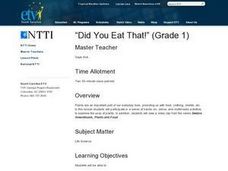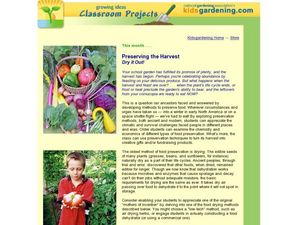Curated OER
Vegetable Party
Students discover the number of fruits and vegetables to eat on a daily basis. They identify the parts of different edible plants and which ones they can eat. They also sample healthy snacks.
Curated OER
Explorit's Foodplant Quiz
In this plants worksheet, learners complete a five question multiple choice on-line interactive quiz about plants grown for food.
Curated OER
Where Does Food Come From?
Students recognize that food we eat comes from farms. In this where does food come from lesson, students discuss planting crops and how they grow. Students plant seeds for edible crops and eat them when are ripe. Students sing a song...
Curated OER
Yummy for my tummy!
First graders read the story Tops and Bottoms and identify vegetables that are eaten from the stem, root, and leaf of a plant. In this vegetables lesson plan, 1st graders learn vocabulary about different vegetable parts and write journal...
Curated OER
Let's Sort a Salad
Students examine edible plants by identifying salad ingredients. In this botany lesson, students discuss the different vegetables that can be eaten in a salad and draw them on a worksheet. Students review vegetable vocabulary and examine...
Curated OER
Cell Reviews
Students draw cells, make a cell, and list organelles in plant and animal cells. In this cells lesson plan, students create edible cells.
Curated OER
"Did You Eat That!"
First graders investigate why plants are an important part of our everyday lives, providing us with food, clothing, shelter, etc. In this lesson plan students participate in a series of hands-on, online, and multimedia activities to...
Cornell University
Study Soil
What's in soil? Young scientists study the pH levels of soil from their school yard. They observe the land and area the soil came from to decide if location has anything to do with acidity level.
Curated OER
Survival of the Fittest
Learners explore plant needs and growth. In this plant science lesson, students use a cereal box to complete a plant growth graph activity.
Calvin Crest Outdoor School
Survival
Equip young campers with important survival knowledge with a set of engaging lessons. Teammates work together to complete three outdoor activities, which include building a shelter, starting a campfire, and finding directions in the...
Curated OER
Planting Rabbit King’s Carrot
Even pirates know not to steal stuff you can make yourself! Read The Pirate's Parrot Stole the King's Carrot to engage your class. Then, plant carrots with your class. If this isn't possible with your kiddos, consider cutting out paper...
Agriculture in the Classroom
Pumpkins... Not Just For Halloween
Celebrate fall with four pumpkin themed hands-on activities! After learning about pumpkins, scholars complete two activity sheets that reinforce estimation and word problems. They then plant pumpkin seeds and bake a pie in a bag.
Curated OER
Soybeans: The Miracle Seed
Students discover why soybeans are called the "miracle seeds." They make their own soynuts and share other foods made from soybeans. They create a bulletin board of soybean products.
Curated OER
Preserving the Harvest: Dry it Out!
Students explore how people preserved their food in the past. In food preservation instructional activity, students create different models that enable someone to dry out food, such as a food dehydrator. Students also learn how to...
Curated OER
Minerals Make Rocks
Students examine that all rocks are made from one or more minerals (or plant material, as in the case of coal). They make mock rocks and discuss the difference between a rock and a mineral.
Curated OER
Limu in Your Lunch
Students explore various types of algae found in Hawaii. In this science lesson, students research species of the three types of limu and identify various uses. Students explore products that contain limu.
Curated OER
Genetic Engineering
Pupils are introduced to the concept of genetic engineering. In groups, they participate in a variety of experiments, in which they analyze the effect of chemicals on different substances. Using the internet, they research gossypol, test...
Curated OER
LISTENING TO DIRECTIONS
Students view farm objects or products made from farm animals and follow the oral instructions given by the teacher. They are given worksheets, there are three sets of directions for the one worksheet. Students worksheets have everything...
Curated OER
A TOUGH NUT TO CRACK
Based on a set of criteria, students will evaluate the quality of pecans.1. Bring a gram scale and papershell pecans. Provide five pecans for each student. 2. Divide the class into groups of five and provide each member with five pecans....
Curated OER
Get Nutty
Students research how nuts and seeds contribute to their overall good health.They recognize that nuts and seeds are a tasty addition to a meal. Students comprehend that nuts and seeds pose a risk for a small proportion of the population...
Curated OER
JUST A MATTER OF TIME
Students recognize the dynamic changes in themselves and in agriculture that have occurred through the years. They are shown pictures of a baby or students are asked to think of their little brothers or sisters or themselves in...
Texas A&M University
Texas A&m University: Plants and People Lab
Extensive lab has students fill out large chart of plant parts, "vegetables", with pictures with information about the scientific name, structure, and origin. Several wrap-up questions are also included to make generalizations about...
BioEd Online
Bio Ed Online: Plant Parts You Eat
Did you know that some plant parts are edible? People rely on many different plants and plant parts for food. In this instructional activity students observe and investigate different plant-originated foods, and learn about plant parts.
University of Illinois
University of Illinois Extension: Great Plant Escape: What Is the Life Cycle of a Plant?
In this interactive lesson, students learn about categories of plants, plant parts, life cycle, what plants need to grow, and edible plant parts.

























